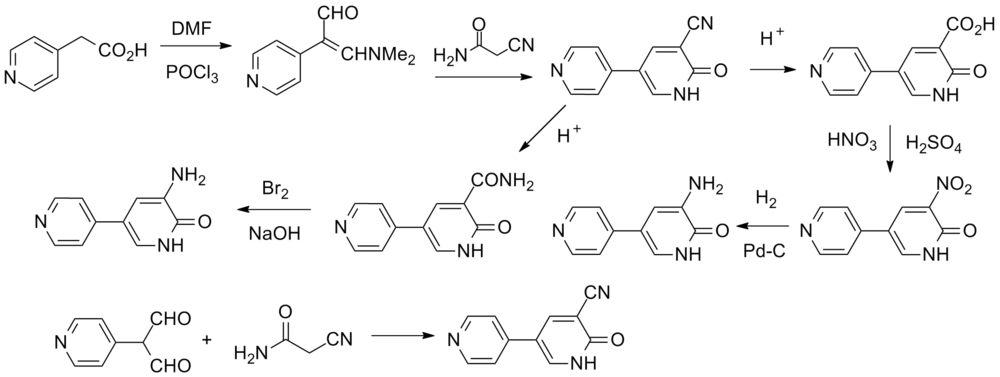Amrinone
 | |
 | |
| Clinical data | |
|---|---|
| Trade names | Inocor |
| Other names | inamrinone (USAN US) |
| AHFS/Drugs.com | International Drug Names |
| Routes of administration | Intravenous |
| ATC code | |
| Legal status | |
| Legal status |
|
| Pharmacokinetic data | |
| Bioavailability | n/a |
| Protein binding | 10 to 49% |
| Metabolism | Hepatic |
| Elimination half-life | 5 to 8 hours |
| Excretion | Renal (63%) and fecal (18%) |
| Identifiers | |
| |
JSmol) | |
| |
| |
| (verify) | |
Amrinone, also known as inamrinone, and sold as Inocor, is a
Actions
Increases cardiac contractility, vasodilator. Acts by inhibiting the breakdown of both cAMP and cGMP by the phosphodiesterase (
PDE-III inhibition and cardiac function
PDE III is present in cardiac muscle, vascular smooth muscle and platelets. PDE III degrades the phosphodiester bond in cAMP to break it down.
Indications
Short-term management of severe CHF (not used long term because of increased mortality, probably due to heart failure).
Effects in congestive heart failure
Congestive heart failure (CHF) is characterized by a reduction in ventricular performance and abnormalities in peripheral circulation and organs.
Contraindications
Patients with aortic stenosis, hypertrophic cardiomyopathy, or history of hypersensitivity to the drug.
Precautions
May increase myocardial ischemia. Blood pressure, pulse, and ECG should be constantly monitored. Amrinone should only be diluted with normal saline or 1/2 normal saline; no dextrose solutions should be used. Furosemide, a loop diuretic, should not be administered into an IV line delivering amrinone.
Side effects
Amrinone discovery and progression
Early studies in patients with heart failure showed that amrinone produced short-term hemodynamic improvement, but had limited long-term clinical benefit.[7] Some serious side effects of long term administration included sustained ventricular tachycardia resulting in circulatory collapse, worsening myocardial ischemia, acute myocardial infarction, and worsening congestive heart failure.[7][11] Amrinone has good absorption from the gastrointestinal tract [12] and has led to gastrointestinal upset when taken orally. The oral form of the drug is no longer in use.[11] Currently, only acute intravenous administration takes place.[11] The effects of amrinone vary widely with species and experimental condition; therefore, its inotropic effects are variable.[3] A loss in sensitivity to phosphodiesterase 3 inhibitors, including amrinone, has been observed in end stage heart failure in humans; other treatment options may be more useful for improvement in these stages.[3]
Naming
Amrinone is the INN, while inamrinone is the United States Adopted Name, which was adopted in 2000 in an attempt to avoid confusion with amiodarone.[13]
Synthesis

See also: Milrinone and Pelrinone.
References
- PMID 10478810.
- ^ PMID 7246440.
- ^ S2CID 6036283.
- ^ Wilmshurst P. "The HealthWatch Award 2003: Dr Peter Wilmshurst - "Obstacles to honesty in medical research"". Archived from the original on 2015-04-25.
- ^ .
- ^ PMID 2909994.
- ^ S2CID 6325011.
- ^ PMID 7379283.
- ^ PMID 3004184.
- PMID 7350759.
- ^ PMID 3530768.
- PMID 39684.
- ^ "Amrinone Becomes Inamrinone". USP Quality Review. 73. United States Pharmacopeia. March 2000. Archived from the original on 2008-10-03.
- ^ US Patent 4004012, Lesher GY, Opalka CJ, "3-Cyano-5-(pyridinyl)-2(1H)-pyridinones", issued 18 January 1977, assigned to STWB Inc.
- ^ US Patent 4072746, Lesher GY, Opalka CJ, "3-Amino-5-(pyridinyl)-2(1H)-pyridinones", issued 7 February 1978, assigned to Aventis Pharmaceuticals Inc.
- ^ US 4107315, Lesher GY, Opalka CJ, "5-(Pyridinyl)-2(1H)-pyridinones", issued 15 August 1978, assigned to Aventis Pharmaceuticals Inc.
- ^ GB 2070008, Gelotte KO, Parady ED, "Process for preparing 5-cyano(3,4'-bipyridin)-6(1H)-one", published 3 September 1981, issued 18 April 1984, assigned to Sterling Drum Inc.
